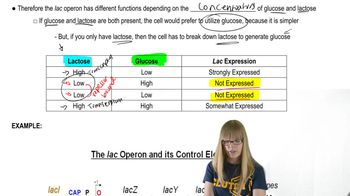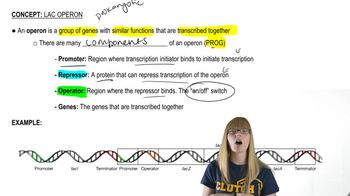Table of contents
- 1. Introduction to Genetics51m
- 2. Mendel's Laws of Inheritance3h 37m
- 3. Extensions to Mendelian Inheritance2h 41m
- 4. Genetic Mapping and Linkage2h 28m
- 5. Genetics of Bacteria and Viruses1h 21m
- 6. Chromosomal Variation1h 48m
- 7. DNA and Chromosome Structure56m
- 8. DNA Replication1h 10m
- 9. Mitosis and Meiosis1h 34m
- 10. Transcription1h 0m
- 11. Translation58m
- 12. Gene Regulation in Prokaryotes1h 19m
- 13. Gene Regulation in Eukaryotes44m
- 14. Genetic Control of Development44m
- 15. Genomes and Genomics1h 50m
- 16. Transposable Elements47m
- 17. Mutation, Repair, and Recombination1h 6m
- 18. Molecular Genetic Tools19m
- 19. Cancer Genetics29m
- 20. Quantitative Genetics1h 26m
- 21. Population Genetics50m
- 22. Evolutionary Genetics29m
12. Gene Regulation in Prokaryotes
Lac Operon
Problem 8a
Textbook Question
The CAP binding site in the lac promoter is the location of positive regulation of gene expression for the operon. Identify what binds at this site to produce positive regulation, under what circumstances binding occurs, and how binding exerts a positive effect.
 Verified step by step guidance
Verified step by step guidance1
Identify the molecule that binds to the CAP binding site: The molecule that binds to the CAP binding site is the catabolite activator protein (CAP), also known as cAMP receptor protein (CRP).
Determine the circumstances under which CAP binds to the site: CAP binds to the CAP binding site when it is complexed with cyclic AMP (cAMP). This occurs when glucose levels are low, leading to an increase in cAMP levels.
Explain how the binding of CAP-cAMP complex occurs: The CAP-cAMP complex binds to the CAP binding site located upstream of the lac operon promoter.
Describe the effect of CAP-cAMP binding on gene expression: The binding of the CAP-cAMP complex facilitates the binding of RNA polymerase to the promoter, enhancing the transcription of the lac operon genes.
Summarize the overall impact of CAP-cAMP binding: The positive regulation by CAP-cAMP ensures that the lac operon is expressed when glucose is scarce and lactose is available, allowing the cell to utilize lactose as an energy source.
Recommended similar problem, with video answer:
 Verified Solution
Verified SolutionThis video solution was recommended by our tutors as helpful for the problem above
Video duration:
3mPlay a video:
Was this helpful?
Key Concepts
Here are the essential concepts you must grasp in order to answer the question correctly.
CAP Protein
The CAP (catabolite activator protein) is a transcription factor that binds to the CAP binding site in the lac promoter. This protein is crucial for the positive regulation of the lac operon, as it enhances the binding of RNA polymerase to the promoter, facilitating the transcription of genes involved in lactose metabolism.
Recommended video:
Guided course

Proteins
cAMP Levels
Cyclic AMP (cAMP) is a signaling molecule that plays a vital role in the regulation of the lac operon. When glucose levels are low, cAMP levels rise, leading to the activation of CAP. The binding of cAMP to CAP is necessary for CAP to attach to the CAP binding site, thus promoting gene expression in the presence of lactose.
Recommended video:
Guided course

Lac Operon Summary
Positive Regulation
Positive regulation refers to the process by which a regulatory protein, such as CAP, increases the likelihood of transcription of a gene. In the case of the lac operon, when CAP binds to the CAP binding site in the presence of cAMP, it enhances RNA polymerase's affinity for the promoter, leading to increased transcription of the operon genes, especially when lactose is available.
Recommended video:
Guided course

Positional Cloning

 4:27m
4:27mWatch next
Master Lac Operon Overview with a bite sized video explanation from Kylia Goodner
Start learning


